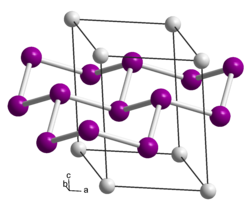Top Qs
Timeline
Chat
Perspective
Calcium disilicide
Chemical compound From Wikipedia, the free encyclopedia
Remove ads
Calcium disilicide (CaSi2) is an inorganic compound, a silicide of calcium. It is a whitish or dark grey to black solid matter with melting point 1033 °C. It is insoluble in water, but may decompose when subjected to moisture, evolving hydrogen and producing calcium hydroxide. It decomposes in hot water, and is flammable and may ignite spontaneously in air.
Industrial calcium silicide usually contains iron and aluminium as the primary contaminants, and low amounts of carbon and sulfur.
Remove ads
Properties
At ambient conditions calcium disilicide exists in two polymorphs, hR9 and hR18; in the hR18 structure the hR9 unit cell is stacked twice along the c axis. Upon heating to 1000 °C at a pressure of ca. 40 kBar, calcium disilicide converts to a (semi-stable) tetragonal phase.[2] The tetragonal phase is a superconductor with a transition temperature of 1.37 K[3] to 1.58 K.[4] Although there is no observable superconducting transition temperature for the trigonal/rhombohedral (i.e. hR9 and hR18 unit cells) at ambient pressure, under high pressure (>12 GPa/120 kbar) this phase has been observed exhibit superconducting transition.[5] When the trigonal phase is placed under pressures exceeding 16 GPa, there is a phase transition to an AlB2-like phase.[6]
Remove ads
Uses
Alloys
Calcium silicide is used for manufacture of special metal alloys, e.g. for removing phosphorus and as a deoxidizer.
Pyrotechnics
In pyrotechnics, it is used as fuel to make special mixtures, e.g. for production of smokes, in flash compositions, and in percussion caps. Specification for pyrotechnic calcium silicide is MIL-C-324C. In some mixtures it may be substituted with ferrosilicon. Silicon-based fuels are used in some time delay mixtures, e.g. for controlling of explosive bolts, hand grenades, and infrared decoys.[citation needed] Smoke compositions often contain hexachloroethane; during burning they produce silicon tetrachloride, which, like titanium tetrachloride used in smoke-screens, reacts with air moisture and produces dense white fog. Gum arabic is used in some mixtures to inhibit calcium silicide decomposition.
Heating food
Self-heating cans of military food rations developed during WWII used a thermite-like mixture of 1:1 iron(II,III) oxide and calcium silicide. Such mixture, when ignited, generates moderate amount of heat and no gaseous products.[7]
Remove ads
References
Wikiwand - on
Seamless Wikipedia browsing. On steroids.
Remove ads

